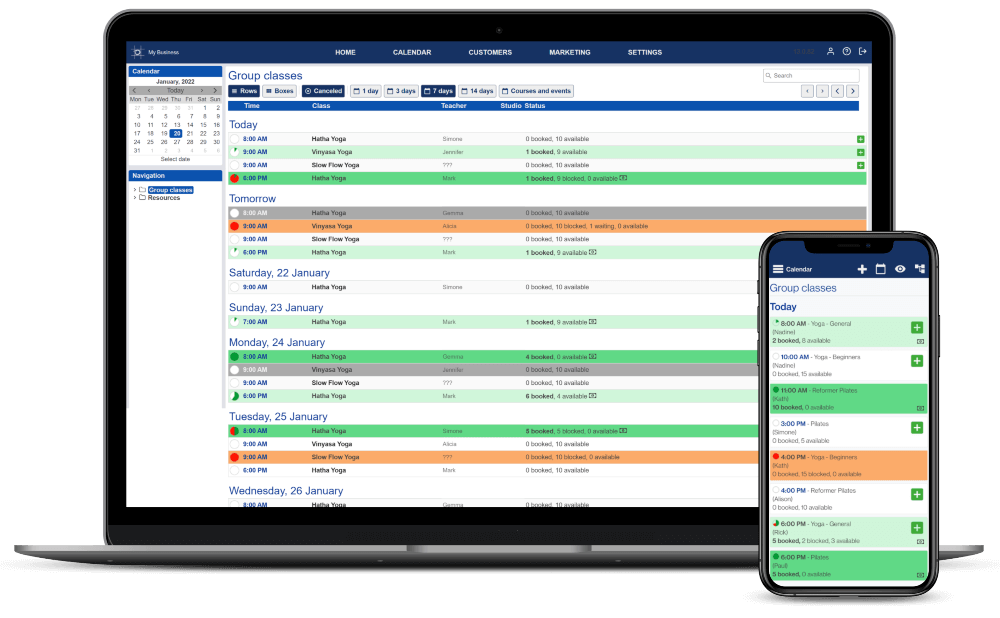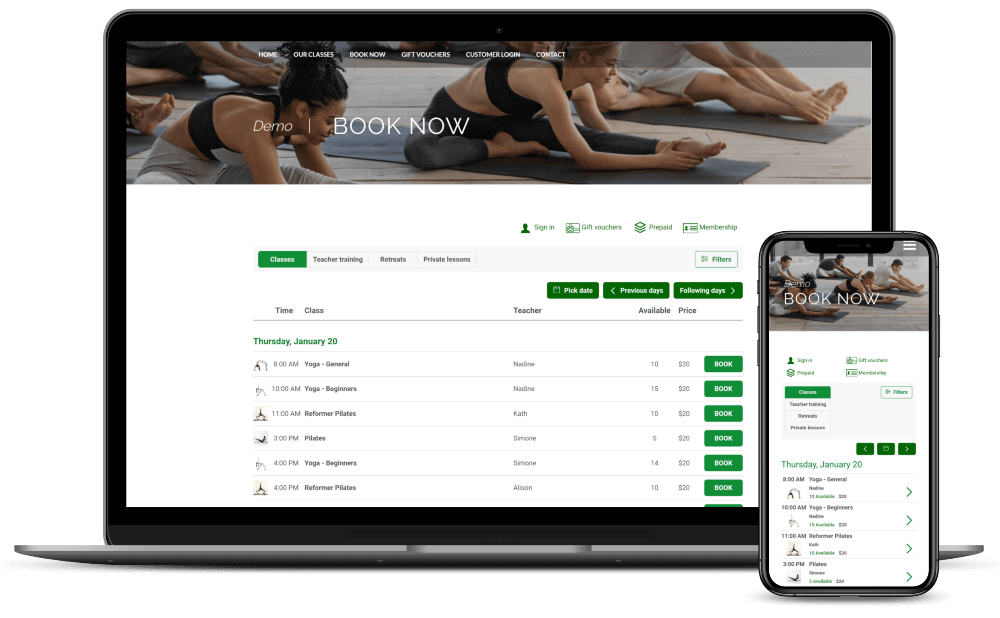
The Complete Guide on How to Start a Fitness Business in 2025
It’s no secret that the fitness industry has been one of the most heavily affected by the global COVID-19 pandemic throughout 2020-2022.
Yet, as we move into 2025, the fitness and wellness industry, in general, has since bounced back very strongly, projected to grow by 171.75% between 2021 and 2028 to reach more than $ 400 billion in market size in the US alone.
This means, if you’ve always got a passion for the fitness niche and wanted to start your own business, there has never been a better time.
Yet, just because the industry is thriving doesn’t mean you’ll automatically achieve success just as soon as you’ve started your gym. You’ll still need proper planning, the right strategy, and especially the right execution if you are looking to achieve success.

In this guide, we will discuss all you need to know about how to start a successful fitness business in 2025. We’ll cover anything from market research to establishing a strong digital presence, and by the end of this guide, you’d have learned about:
- How to perform thorough market research for your fitness business
- Developing a business plan
- Legal considerations before starting your fitness business
- Choosing the right location
- Choosing the necessary equipment and planning the procurement process
- Staffing
- Marketing and promoting your fitness business
- Business operations, including establishing a 24/7 online booking system
- Establishing a strong digital presence
And more.
Without further ado, let’s start this guide by discussing one of the most important foundations of your fitness business’s potential success: market research.
Step 1: Market research
Before we even start planning our fitness business, it’s important to first perform extensive market research to ensure the feasibility of your business and to help you develop a successful strategy.

When performing your market research, here are some key points to consider:
Identify demand and potential market size
It’s critical to first identify whether there’s enough demand for fitness services in the location. Here are some steps you can take:
- Demographic research: analyze the demographics of the location where you plan to start your fitness business. Look at factors like age, education level, and income level to estimate the potential size of your target market.
- Market trends: use tools like Google Trends, and analyze available industry reports and trends to identify areas or sectors where there is high demand, where there may be room for growth and the overall demand for fitness services in the area.

- Check out the competition: check out the existing fitness businesses in the area, and if possible, visit them one by one. If there are many successful gyms, yoga classes, and other fitness services in the area, it’s a strong sign that there’s a strong demand in the location.
- Surveys, interviews, and focus group discussions: ask potential customers about their fitness habits, preferences, needs, and challenges by sending surveys (online or offline) or inviting them to interviews/focus group discussions. This can provide you with valuable insights into your target audience’s preferences, including what types of fitness services are in high demand.
Competitive analysis
Once you have identified the demand for fitness business in the area, you should continue by analyzing your potential competitors in the area.
First, list all fitness businesses in the area: gyms, studios, yoga classes, personal fitness services, etc. Start planning how you are going to set your business apart from them and develop your unique value proposition (UVP.)
When evaluating different competitors, also pay attention to their marketing approaches, pricing strategies, services they offer, and customer reviews. Analyze what worked and what didn’t.
Choose what fitness services to offer
Based on your market research and competitive analysis results, choose what type (or types) of fitness service you offer.
It’s critical to choose the service that aligns well with your expertise, interest, and target market. Consider how you can differentiate yourself from other fitness businesses in the area, and how you can deliver the best possible value for your target audience.
Some types of fitness businesses you can consider include:
- Traditional gyms: or fitness centers. This type of fitness service requires a fairly large space where you can store your equipment (cardio and weight training.) You can also offer fitness classes and amenities like saunas, locker rooms, saunas, etc.
- Boutique fitness studios: smaller fitness studios, typically offer more specialized services that focus only on a specific type of workout or exercise. For example, Yoga studios, pilates studios, HIIT studios, and others.

- Personal training services: offering one-on-one (or sometimes, small group) training programs tailored to the client’s specific needs or goals. The class can take place in a gym, a studio (rented), or even in the client’s house.
- Online fitness services: virtual fitness classes or courses that users can access on their devices. You may offer virtual coaching sessions (i.e., via Zoom), an app containing personalized training plans, publishing pre-recorded training/workout videos, or other online business models.
Of course, you can offer multiple types of services, and there are many other business models and opportunities for innovation you can experiment with. To be successful, the idea is to either find a unique niche you can serve or offer an innovative approach to an existing market.
Step 2: Fitness business planning
Now that you’ve performed your market research and identified a niche to pursue, in this step, we’ll focus on establishing a solid plan for your business.
There are four key considerations you should have in this step:
- Developing a great business plan
- Identify startup cost
- Secure funding options
- Register your business as a legal entity
1. Developing a business plan
A business plan is especially useful if you are planning to secure outside funding for starting your fitness business (i.e., getting loans, convincing investors, etc.) However, even if you plan to start the business on your own, a business plan will still give you a useful roadmap to help you make informed decisions as you run your business to achieve success.

The business plan should include your business’s goals or objectives, strategies to achieve success, and financial projections. You can technically format and structure your business plan as you see fit, but here is a typical format you can follow:
- Executive summary: this section contains the summary of the whole business plan and should provide an overview of your business, including your mission statement, target market, services and products you offer, and financial projections.
- Market research: includes the analysis and results of your market research (as we’ve discussed in the previous section.) Discuss the demographics of your target market, market size, competition, and market trends.
- Services and products: describes the services and complimentary products your fitness business will offer. Include details like pricing, delivery methods (if any), packaging, and others.
- Marketing and sales plan: this section discusses your marketing and sales strategies, including advertising, social media strategy, promotion plans, and other customer acquisition efforts.
- Operational plan: this section describes your fitness business’s day-to-day operations, including staffing, equipment procurement, facilities management, policies & procedures, etc.
- Financial plan: this section outlines your funding needs (budget), source of funding, etc. If you plan to secure external funding (loans, investments, grants, etc.,) discuss them in this section.
- Management team: this section should introduce your management team, including their past experience and qualifications.
- Milestones and objectives: describe the key milestones you hope to achieve in the fitness business (i.e., reaching a specific number of members after six months.)
- Appendices: any additional but relevant information goes here, such as competitive analysis results, legal documents, market research numbers, etc.
Again, keep in mind that you can add other sections and content to the business plan as you see fit, so you don’t have to stick with this structure. What’s important is to make sure your business plan aligns well with your specific business needs and goals.
2. Identify startup costs
Starting a fitness business will obviously involve high startup costs.
Thus, it’s important to identify all the costs associated with starting and running the fitness business, so you can develop an accurate budget and secure your funding.

Here are some elements of startup costs you may need to consider:
- Equipment: often the most significant expense in starting an in-person fitness business. Including items like cardio machines, yoga mats, weightlifting equipment, and other types of fitness equipment.
- Rent and utilities: if you plan to open a physical location (i.e., a fitness center, yoga studio, etc.), then you’ll need to take the cost of rent (or purchase), utilities, and other expenses associated with your property, including repairs and maintenance costs.
- Marketing and promotional expenses: including the cost of creating a website, advertising, social media marketing costs, printing flyers/brochures, etc.
- Staffing costs: if you plan to hire employees for your fitness business, factor in salaries, benefits, and other labor costs (i.e., training) into your budget.
Identify relevant startup costs of the fitness business, and estimate your budget so you can secure the adequate amount of funds necessary to launch and run the fitness business successfully, as we’ll discuss in the next section.
3. Secure funding options
Once you’ve identified the required startup costs, then this section will be about exploring funding options to cover these costs.
Some popular ways to secure funding for your fitness business include:
- Personal savings: you can use your personal savings to cover your startup costs. An extension of this would be securing soft loans from friends or family members.
- Loans: obtain a loan from a bank or other financial institution. If you plan to secure loans, most likely, you’ll need to have a sound business plan and good credit.

- Crowdfunding: for certain business models, you may be able to raise funds on crowdfunding platforms from those who support your fitness business idea.
- Grants: you may be able to apply for grants from nonprofit organizations that support small businesses or from government agencies.
- Investments: securing external investments. Similar to bank loans, typically, this method will require you to present a solid business plan.
4. Register your business
Last but not least, register your fitness business to protect your business from legal liability in the future.
The specific steps you’ll need to take to register your business may vary depending on your location, the type of business entity you choose (Sole proprietorship, partnership, LLC, corporation, etc.,) and other factors. However, here are the typical steps you’ll need to take:
- Choose a business name. Make sure it’s easy to pronounce and remember and check its availability. Most likely, you can check this by visiting the website of the government agency responsible for handling business registrations in your state (i.e., the Secretary of State’s website.)
- It’s also important to check if the domain name for your business website is available, as well as social media handles.
- Register your business name with your local government.
- Choose a business structure, such as sole proprietorship, corporation, LLC, or other types
- Fill out an application and register your business with your state’s Secretary of State office or any other government agency that handles business registrations in your area

- Obtain necessary licenses and permits. You may need to obtain different licenses and permits depending on your location, so check out the requirements in your area first.
- Obtain Employer Identification Number (EIN) by applying through the IRS website. EIN is a unique nine-digit number that identifies your business for taxation purposes.
- Open a business bank account. Make sure to separate your business bank account from your personal account to keep your business finances separate.
If necessary, consult with a legal consultant or a lawyer in your area to ensure that your business stays compliant with all legal requirements in your location.
Other legal considerations you may need to pay attention to:
- Insurance requirements: you may be held liable if a client or customer is injured in your fitness class or on your premises. In this case, having the right liability insurance can help protect you and your fitness business from the financial impact of these incidents. Depending on your location, having your business insured may be a legal requirement before you can start a fitness business.

- Contracts with clients: especially if your fitness business offers memberships or subscription-based services, having a well-written contract with your clients/members are important to help protect you and your business from potential legal liabilities. Your contract should clearly outline the services you will provide and their exact price, as well as any other terms and conditions. We’d recommend working with a lawyer to draft the contract to make sure it complies with all legal requirements in your area.

Step 3: Choosing the right location and equipment
Note: if you are going to start an online-only fitness business (i.e., a fitness lesson app, then you can skip this step.)
For in-person fitness businesses (fitness centers, yoga studios, etc.), choosing the right location and equipment is arguably the most important factor for the success of your fitness business.
Here are some critical factors to consider:
- Choosing an ideal location: whether you are choosing the right location can make or break your fitness business. It’s critical to look for a location that is accessible and appropriate for your target market. Consider the demographics of the area, foot traffic, parking availability, and proximity to public transportation. Make sure to choose a location that fits your target audience’s preferences and demographic profile.

- List your required equipment: depending on the type of fitness business you’re going to start and the services you are going to provide, you may need different types of equipment. If you are starting a gym center, then you’ll most likely need a range of weightlifting equipment and cardio machines. On the other hand, if you are starting a yoga studio, you may only need to invest in yoga mats and blocks. Have a detailed list of the required equipment, and determine the required cost.
- Purchasing vs. leasing equipment: when it comes to procuring the required equipment, you have two basic options, whether to purchase or lease it. Purchasing the equipment means a more expensive upfront investment, but it can let you save more money in the long run and vice versa. Leasing your equipment may be a good option if you have limited capital or if you are not sure about investing in a specific type of equipment and want to test it out first.
Also, when it comes to selecting equipment, it’s important to maintain the right balance between quality/durability and price. More affordable equipment may save you money upfront, but if it breaks easily, it may cost you more in the long run.

Be more careful in evaluating the quality and durability of each piece of equipment before committing to a purchase or lease.
Step 4: Building a team for your fitness business
One of the most critical aspects of starting a fitness business is preparing your team, and here are the steps to follow:
- Determine staffing needs: it’s critical to first determine the staffing needs for your fitness business. Carefully assess how many trainers you’ll need in your team, how many receptionists/front desk staff, and so on.
- Hire staff members: once you’ve identified your staffing needs, it’s time to recruit your staff members. You can post job openings on online/offline job boards, social media, or other channels to look for individuals with relevant job experience and/or certifications.
- Onboarding and training: ensure you have a proper onboarding program in place for newly hired staff members to ensure they are properly trained for their duties. You may need to include training on equipment use, safety protocols, and customer service excellence. Provide ongoing and up-to-date training to refresh your staff members with the latest industry trends and techniques.

Remember that your staff members’ performance and quality will have a very significant impact on your reputation. Make sure to invest enough time and resources to hire and train the right people.
Step 5: Develop and execute marketing and sales plan
Marketing and sales are obviously crucial for any business’s success, including your fitness business.
Here are some critical steps you should take to effectively market your fitness business to attract and retain customers:
- Develop a marketing strategy: develop a clear and comprehensive marketing plan. This plan should include identifying your target audience, defining your unique value proposition (UVP), and deciding on the best marketing channels for reaching prospective customers.
- Promote your business: execute your marketing plan. This can involve setting up your website, creating social media accounts, developing marketing materials, and advertising your fitness business through various channels. Also, encourage positive reviews and referrals from existing clients/members. Consider partnering with relevant influencers or other businesses to amplify your reach.
- Create sales incentives: consider developing a sales incentive scheme to encourage potential customers to sign up. For example, you can offer a limited-time discounter membership rate or a free fitness assessment. Also, develop sales incentives to encourage retention, like loyalty promotions and discounts or referral bonuses for current customers who bring in new members.
Step 6: Creating and optimizing business operations
To make sure a streamlined and optimal day-to-day operation of your fitness business, here are some critical steps to follow:
- Establish clear business policies: create and communicate policies and guidelines for both staff and clients/members to help ensure consistent service. This may include policies around membership cancellation, use of equipment, late arrival, etc.
- Develop optimal pricing structure: it’s important to find the sweet spot between generating a profit while staying competitive within your market. Conduct market research and competitive analysis to identify the right pricing structure for your services. Consider offering discounts for bulk purchases to encourage referrals and repeat businesses.
- Establish a scheduling system: in this post-COVID era, many customers simply prefer the flexibility and convenience of online scheduling. Consider investing in an online 24/7 booking system so clients/members can book your fitness classes and sessions at their convenience:
- There is a variety of online appointment software for yoga studios available with varying features and price points. Bookeo offers a flexible 24/7 appointment scheduling solution at a competitive price.
- Set up the scheduling software and integrate it with your website and social media platforms to streamline the booking process.
- Train your staff members on how to use the online scheduling system effectively.

- Establish policies and guidelines for scheduling: To prevent confusion, make sure the policies are clear and well-communicated. Consider policies for cancellations or appointment changes with minimum notice requirements.
Step 7: Establish a strong digital presence
Having a strong online presence is critical for any business to connect with its target audience, build brand identity, and acquire new customers.
Specific to a fitness business, here are the steps you can follow to build a strong digital presence:
- Build a website
A professional website is critical for any business. Even if you already have a strong social media presence, your social profiles aren’t adequate replacements for a well-designed, functional website.
Your website is often the first place prospective customers will go to learn about your fitness business, your services, and pricing information. If your first impression is bad, it’s going to be very difficult to keep them interested.
Your website should be well-designed, easy to navigate, fast to load, and mobile-friendly. Include all the important information about your fitness business, and place effective CTAs to encourage conversions.
- Optimize for SEO
Implement SEO best practices to help your website and its content appear higher in search engine results pages (SERPs.) By ranking higher, you can ensure potential customers can find your fitness business when they search for relevant keywords related to fitness services.

If necessary, consider getting help from a marketing agency or SEO professional to help you optimize your content and website’s technical factors.
- Build a strong social media presence
Leverage Facebook, Instagram, Twitter, and other social media platforms to reach a wider audience and build awareness of your brand. Post content that showcases your services, client testimonials/success stories, and upcoming events.

Also, remember that social media is a two-way communication medium, so use these platforms to engage with your audience. Respond to comments (including negative ones), and messages, and consider running paid ads to amplify your reach.
- Integrate the online booking system
As discussed in the previous step, integrate your chosen online booking system on your website and social media platform.
In fact, ideally, the 24/7 appointment system should be the core element of your website and should be displayed prominently. This can be done by including a prominent CTA button (i.e., a “Book Now” button or widget) in an optimal place.

Focus on making the entire booking process streamlined, straightforward, and as easy as possible for your clients/members. Consider offering incentives for clients who book online, like small discounts, to help introduce the online booking function.
Wrapping Up
Starting a fitness business is definitely a lucrative business opportunity, but it still requires careful planning and execution if you want to achieve success.
By following the steps outlined in this guide, you can establish a strong foundation for your fitness business to attract more clients, retain existing members, and continually grow.
With dedication, attention to detail, and hard work, it’s definitely possible to turn your passion for fitness into a profitable business.

